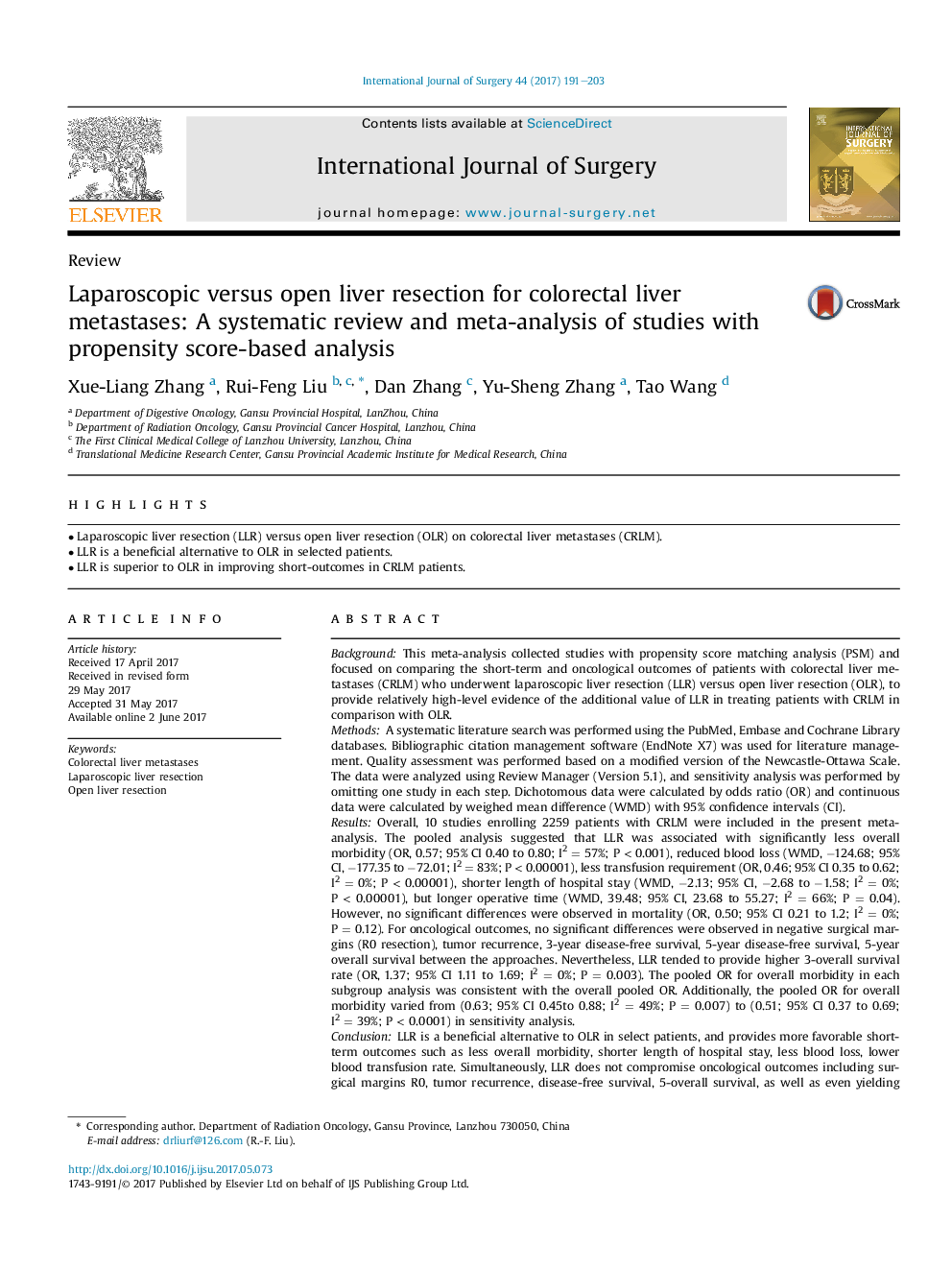| کد مقاله | کد نشریه | سال انتشار | مقاله انگلیسی | نسخه تمام متن |
|---|---|---|---|---|
| 5731644 | 1611934 | 2017 | 13 صفحه PDF | دانلود رایگان |
- Laparoscopic liver resection (LLR) versus open liver resection (OLR) on colorectal liver metastases (CRLM).
- LLR is a beneficial alternative to OLR in selected patients.
- LLR is superior to OLR in improving short-outcomes in CRLM patients.
BackgroundThis meta-analysis collected studies with propensity score matching analysis (PSM) and focused on comparing the short-term and oncological outcomes of patients with colorectal liver metastases (CRLM) who underwent laparoscopic liver resection (LLR) versus open liver resection (OLR), to provide relatively high-level evidence of the additional value of LLR in treating patients with CRLM in comparison with OLR.MethodsA systematic literature search was performed using the PubMed, Embase and Cochrane Library databases. Bibliographic citation management software (EndNote X7) was used for literature management. Quality assessment was performed based on a modified version of the Newcastle-Ottawa Scale. The data were analyzed using Review Manager (Version 5.1), and sensitivity analysis was performed by omitting one study in each step. Dichotomous data were calculated by odds ratio (OR) and continuous data were calculated by weighed mean difference (WMD) with 95% confidence intervals (CI).ResultsOverall, 10 studies enrolling 2259 patients with CRLM were included in the present meta-analysis. The pooled analysis suggested that LLR was associated with significantly less overall morbidity (OR, 0.57; 95% CI 0.40 to 0.80; I2 = 57%; P < 0.001), reduced blood loss (WMD, â124.68; 95% CI, â177.35 to â72.01; I2 = 83%; P < 0.00001), less transfusion requirement (OR, 0.46; 95% CI 0.35 to 0.62; I2 = 0%; P < 0.00001), shorter length of hospital stay (WMD, â2.13; 95% CI, â2.68 to â1.58; I2 = 0%; P < 0.00001), but longer operative time (WMD, 39.48; 95% CI, 23.68 to 55.27; I2 = 66%; P = 0.04). However, no significant differences were observed in mortality (OR, 0.50; 95% CI 0.21 to 1.2; I2 = 0%; P = 0.12). For oncological outcomes, no significant differences were observed in negative surgical margins (R0 resection), tumor recurrence, 3-year disease-free survival, 5-year disease-free survival, 5-year overall survival between the approaches. Nevertheless, LLR tended to provide higher 3-overall survival rate (OR, 1.37; 95% CI 1.11 to 1.69; I2 = 0%; P = 0.003). The pooled OR for overall morbidity in each subgroup analysis was consistent with the overall pooled OR. Additionally, the pooled OR for overall morbidity varied from (0.63; 95% CI 0.45to 0.88; I2 = 49%; P = 0.007) to (0.51; 95% CI 0.37 to 0.69; I2 = 39%; P < 0.0001) in sensitivity analysis.ConclusionLLR is a beneficial alternative to OLR in select patients, and provides more favorable short-term outcomes such as less overall morbidity, shorter length of hospital stay, less blood loss, lower blood transfusion rate. Simultaneously, LLR does not compromise oncological outcomes including surgical margins R0, tumor recurrence, disease-free survival, 5-overall survival, as well as even yielding better 3-overall survival. Considering unavoidable bias from non-randomized trials, high-quality RCTs are badly needed to determine whether LLR can become standard practice for treating patients with CRLM.
Journal: International Journal of Surgery - Volume 44, August 2017, Pages 191-203
